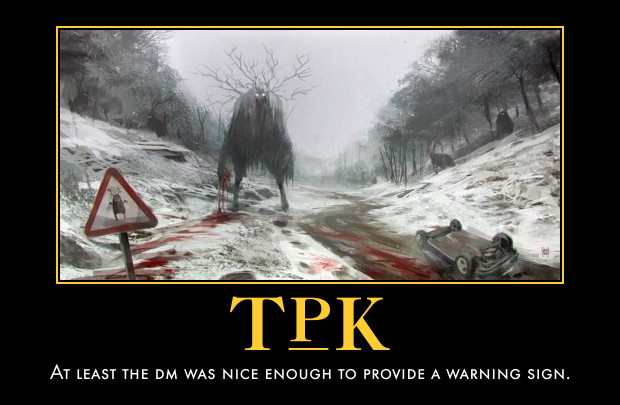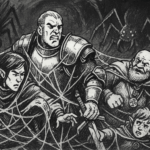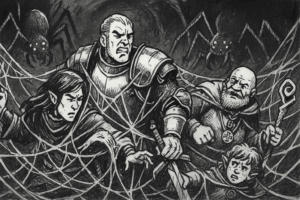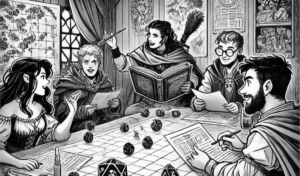
Fellow dungeon masters and players alike, I write to you today about one of the most fundamental challenges facing any party of adventurers: surviving the deadly depths of a properly stocked dungeon. Too many promising campaigns have ended in tears and crumpled character sheets when brave but foolish adventurers charge headlong into dangers they neither understood nor prepared for.
The truth is stark: dungeons are not designed for your convenience. They are organic ecosystems of peril where a first-level party might encounter anything from lowly kobolds to ancient dragons. The dungeon cares nothing for your character’s backstory or your carefully planned build. It will kill you without hesitation if you let it.
What can you do to reduce the party’s risk?
Intelligence Gathering
Locals. Talk with the locals about the dungeon site. They might have details on who lived there, what monsters are where, what has been raiding from there and maybe even details or a map. Collecting rumors can improve survivability considerably.
Tavern Tales and Survivor Stories. Do not simply converse with any peasant you encounter. Seek out former adventurers, merchants who have lost caravans to dungeon denizens, and survivors of previous expeditions. Purchase them ale and listen with care. Cross-reference multiple accounts to separate fact from fiction. A grizzled veteran’s warning about “the screaming room on the second level” might save your lives.
Research the History. Visit libraries, temples, or sage guilds to learn about the dungeon’s original purpose. Was it a tomb? A fortress? A wizard’s laboratory? Understanding the original inhabitants helps predict what dangers remain. Ancient burial sites might have undead, while abandoned wizard towers could contain dangerous magical experiments gone wrong.
Stealth and Movement
Be quiet. Running through a dungeon with no regard for noise can lead to some really great TPKs. Monsters are attracted to sound and very often they will join into an ongoing battle. On the flip side, the party should be moving quietly around and listening when they have an opportunity. They can avoid many monsters if they can get advance warning by listening for them.
Light Discipline. Torches and lanterns announce your presence from great distances. Consider employing hooded lanterns, bulls-eye lanterns for focused illumination, or magical light sources that can be quickly extinguished. In certain circumstances, operating in complete darkness with infravision or other heightened senses might prove safer than advertising your location to every fell creature in the dungeon.
Movement Formation. Establish a standard marching order and adhere to it religiously. Position your most perceptive characters at point and rear guard positions. Keep your magic-users and other fragile party members in the protected center. Practice moving quietly as a group; one clumsy fighter in plate mail can negate the entire party’s stealth efforts.
Reconnaissance and Preparation
Base camp. Camping out where you can observe the dungeon entrance is a good place to start. Watch for monsters coming and going – kinds, how many, weapons, etc. If there’s regular intelligent NPC or monster traffic in and out, watch for pass codes, recognition signs, badges, or other means of authentication. This will help you to be better prepared. This camp can also be a great place to retreat to in the event the party needs to rest in safety to recover.
Scout ahead. Sending the party halfling to sneak around and gather intelligence is another way to stay alive. If you don’t want to risk a character, send in some hirelings instead. They might not all come back out alive, but the ones that do will have first hand knowledge of what to expect. Try being sneaky and stealing treasure or sabotaging enemies, you still get experience, and worst case you are in the same position as attacking outright.
Map as You Go. Designate someone as the party mapper and keep detailed records of your exploration. Note trap locations, monster encounters, treasure found, and safe rooms. This information becomes invaluable if you need to retreat quickly or return later. Include details like “ceiling height varies here” or “wet footprints leading north.”
Use Familiars and Animal Companions. If anyone has a familiar, animal companion, or even trained animals, send them to scout dangerous areas first. A raven can fly through corridors checking for obvious threats, while a dog’s keen senses might detect monsters around corners. Their loss is tragic but better than losing a party member.
Combat Avoidance and Tactical Retreat
Distract monsters. Monsters may stop chasing you if you throw food or treasure behind you as you escape. Hungry wolves would much rather eat a mutton chop than have to chase you all over. And goblins love shiny loot and will pick up every coin they can find. Pack animals also make good sacrifices for larger monsters as well as giving the party additional carrying capacity.
Know When to Run. There’s no shame in tactical retreat. If you encounter something obviously beyond your capabilities (ancient dragon, lich, army of orcs), flee immediately. Live to fight another day when you’re better prepared. Establish retreat signals beforehand so the party can coordinate escape attempts.
Divide and Conquer. When facing groups of enemies, try to separate them. Use chokepoints, doors, and terrain to fight smaller numbers at once. Slam doors behind you to split enemy forces. Lure some monsters away from the main group using noise or bait.
Negotiation and Bribery. Not every encounter needs to end in violence. Many intelligent monsters can be reasoned with, bribed, or convinced to let you pass. Goblins might accept tribute, bandits might take bribes, and even some undead retain enough intelligence to bargain with. Learn a few words in common monster languages—it might save your life.
Resource Management and Equipment
Pack Smart Equipment. Bring the right tools for dungeon delving: rope (lots of it), pitons, hammers, crowbars, wooden stakes, holy water, iron spikes for wedging doors, oil for burning things, mirrors for checking around corners, and pole arms for triggering traps from a distance. A 10-foot pole isn’t just a meme—it’s a lifesaver.
Manage Spell Resources Carefully. Spellcasters should conserve their most powerful spells for true emergencies. Use cantrips and lower-level spells for routine problems. Consider which spells provide the most bang for your buck in terms of survival: healing, escape options, and area denial effects often outweigh pure damage dealing.
Ration Management. Bring more food and water than you think you need. Dungeon delving is exhausting work, and you might be trapped longer than expected. Hunger and thirst penalties can be the difference between success and TPK when you finally face the big bad.
Exploration Techniques
Search Everything. I can’t say this enough. There can be hidden doors, chests, monsters and more lurking just behind that next search check. Having valuable treasure you found or using the secret entrance can make a huge difference in the outcomes of the adventure. When you search, don’t forget the ceiling or possible traps.
Test Before You Trust. Use your 10-foot pole to test floors for pressure plates, probe pools for depth, and trigger suspected traps from a safe distance. Drop a coin down suspicious corridors to test for noise-triggered traps. Check doors for traps before opening them, and always listen at doors before entering new rooms.
Mark Your Territory. Leave subtle marks to indicate which areas you’ve explored and which contain dangers. Chalk marks, small piles of stones, or scratches on walls can help you navigate complex dungeons and avoid walking into the same trap twice. Establish a simple code system the whole party understands.
Tactical Considerations
Secure, then loot. Don’t start hauling unwieldy solid gold statues through areas which you haven’t thoroughly explored. Investigate the whole dungeon first and then do a second sweep for loot. Of course keep some items as you go, but don’t go hauling a golden statue through the whole dungeon.
Control Your Battlefield. Use the environment to your advantage. Fight from doorways to limit how many enemies can attack you at once. Use furniture for cover. Set fires to create smoke screens or area denial. Collapse weak ceilings or walls to block pursuit routes or create new passages.
Manage Fatigue and Morale. Keep track of how tired and stressed your party is becoming. Exhausted, demoralized adventurers make poor decisions and fight poorly. Take breaks in secure areas, share encouraging words, and don’t push deeper when the party is already stretched thin.
Party Composition and Roles
Diversify Your Skills. Ensure your party covers essential roles: someone who can pick locks and find traps, someone who can turn or deal with undead, someone with healing capabilities, and someone who can handle combat. Missing any of these core competencies dramatically increases your risk.
Establish Clear Communication. Develop hand signals for silent communication underground. Agree on who makes tactical decisions in combat and exploration. Confusion and argument in the middle of a dangerous situation often leads to disaster.
Cross-Train Critical Skills. Don’t put all your eggs in one basket. If only one person can pick locks and they go down, the party is stuck. Have backup plans and consider teaching critical skills to multiple party members when possible.
Emergency Protocols
Escape Routes and Rally Points. Always know where your nearest exit is and have a predetermined rally point outside the dungeon if the party gets separated. Practice emergency signals and develop protocols for different disaster scenarios.
Emergency Gear Distribution. Distribute critical survival gear among party members so losing one person doesn’t doom everyone. Multiple people should carry healing potions, rope, and basic tools. Never let one person carry all the party’s most important equipment.
Dead Man’s Switches. Leave instructions with trusted NPCs about what to do if your party doesn’t return by a certain time. They might send rescue parties or at least retrieve your bodies for resurrection attempts.
Advanced Survival Tactics
Environmental Awareness. Pay attention to air currents (they indicate other entrances/exits), water sources (necessary for long expeditions), and structural integrity. Flooding, cave-ins, and toxic gases kill more adventurers than monsters do.
Monster Behavior Patterns. Study how different creature types behave. Undead never tire and will pursue relentlessly, but many living creatures have feeding schedules, territorial boundaries, and predictable patrol routes you can exploit.
Political Intelligence. In complex dungeons with multiple intelligent factions, learn the political landscape. Perhaps the orcs and goblins are at war, or the cultists fear the undead in the lower levels. Play factions against each other rather than fighting everyone.
Timing Your Delves. Consider seasonal factors, lunar cycles, and known monster behavior patterns when planning expeditions. Some creatures are more active at certain times, and environmental conditions might favor your approach.
Equipment Essentials Checklist
Standard Gear:
- 10-foot poles (multiple)
- 50+ feet of rope
- Grappling hooks
- Crowbars and hammers
- Iron spikes and wooden stakes
- Mirrors (for checking around corners)
- Oil flasks (for burning and slipping)
- Holy water
- Silver weapons (for specific monster types)
Consumables:
- Extra rations (more than you think you need)
- Water (or purification methods)
- Healing potions
- Antitoxins
- Torches/lantern oil
- Spare weapons
Utility Items:
- Chalk for marking
- Small bells (for alarm systems)
- Caltrops (for slowing pursuit)
- Acid (for destroying equipment or barriers)
- Net (for capture or hindrance)
Final Thoughts
Remember, in Old School games, the goal isn’t always to clear every room and kill every monster. Sometimes the greatest victory is retrieving the treasure and getting everyone home alive. Discretion is often the better part of valor, and a successful retreat can set you up for a more informed and better-equipped return expedition.
The key to survival is preparation, caution, and knowing when to cut your losses. Your characters may be heroes, but dead heroes help no one. Think like careful professionals rather than glory-seeking warriors, and you’ll find your survival rate improves dramatically.
What other survival tactics have worked for your party? Share your hard-won wisdom in the comments below!
Discover more from Cresthaven RPG
Subscribe to get the latest posts sent to your email.
















But its such a nice golden statue! What is some pack of thieving adventurers comes in and takes it while I’m off being a hero?
The your DM doesn’t liked you 😉